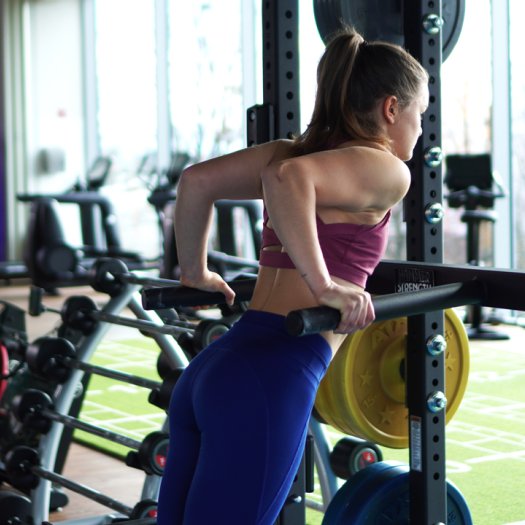The term "calisthenics" comes from the Greek and translates as "beautiful strength". In contrast to pure strength training with weights, here it's about more: In calisthenics, the movements are performed in a controlled and graceful manner. The basic exercises do not require any equipment at all. The best basic Calisthenics exercises are for example:
- Push-ups
- Squats
- Sit-ups
With time, you can then integrate some tools into the training. These are in particular:
- Pull-up bars
- Hanging bars
- wall bars
- parallel bars.
Since the sport is becoming increasingly popular, there are now even special outdoor calisthenics parks in every major city, where you can find bars, parallel bars and other sports equipment.
The advantage is that you don't have to train alone in a quiet room, but can get in touch with like-minded people and exchange ideas. If you don't have a park near you, you can also use climbing frames in playgrounds, clothes poles or branches in the woods that can bear weight.
Even in the origins of calisthenics exercises, which partly originated in New York in the street workout scene, athletes first integrated street signs, benches, scaffolding or wall ledges into the workout. This simplicity - effective training when and where you want - is what makes calisthenics exercises so popular. Even people who have little time and money can get a strong and supple body.
With Calisthenics exercises you can stabilize your musculoskeletal system in the long run and improve your posture. Better posture reduces postural deformities caused, for example, by sitting at a desk for long periods of time. Calisthenics exercises can help reduce or relieve shoulder, neck and throat tension.
As you learn to be more aware and mindful of your body overall, you will automatically develop a healthier gait and more ergonomic movements. Mobilization, which is part of the workout, is also a type of fascial training that allows your muscles to become flexible and supple. Because of the very deliberate, controlled movements, calisthenics can also be somewhat meditative. Athletes of the sport often report feeling more focused and internally balanced as a result of regular training. In addition, the potential for injury is reduced compared to training that consists of jerky and hectic movements.
Last, of course, muscle is built, helping to improve overall fitness, strength and well-being. In addition to the calories burned in extended workouts, building muscle also benefits calorie balance, as muscle burns more calories than fat. Calisthenics exercises, unlike classic weight training, have the great advantage of being a full-body workout. It uses all muscle groups at the same time and thus also promotes coordination. In addition to shoulder, arm and chest muscles, push-ups alone also train the entire body core, which stabilizes and holds you so that you don't sag downward during the exercise. Strength training on equipment, on the other hand, often trains only isolated muscles and thus also neglects the application-related coordination of the muscle groups with each other.
When you start calisthenics training, it is important to first practice the basics and build up a certain basic fitness. Only when you have mastered these and can perform them in a clean and controlled manner does it make sense to move on to more difficult calisthenics exercises. This is especially important to avoid injuries and to ensure long-term progress and motivation.
The difficulty of Calisthenics exercises can be progressively increased for all exercises: when you realize that you have mastered an exercise, you replace it in your training plan with a more strenuous variation or increase the repetitions and intensity.
The best example of this is push-ups: if the "normal push-ups" are still too difficult for you, you can, for example, raise your hands and thus reduce the weight on your arms. You can then gradually reduce the difference in height between your hands and feet. If push-ups are too easy for you, you can perform the exercise with one arm or vary the height of the foot position.
Here are some of the best Calisthenics exercises for beginners:
The best calisthenics exercises for beginners include:
- Dips
- Push-ups
- Handstand
- Pull-up / chin-ups
- Rows
- Skin-the-Cat
- Deadlift
- Glute Bridge
- Squats / Squats
- Lunges
- Plank
- Hollow Hold
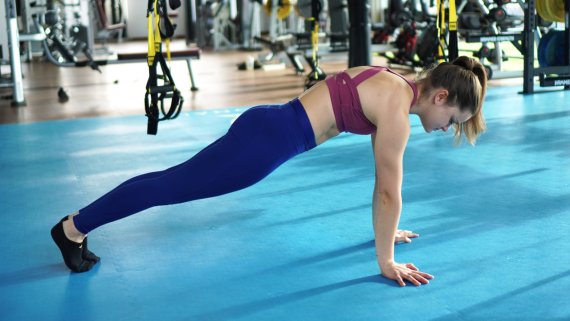
Start on your knees and place your hands about shoulder width in front of you. Then extend your legs so that your entire body forms a straight line and your shoulders are aligned directly over your hands. To begin the calisthenics exercise, extend your feet as if you were going up on your toes and lower your body towards the ground in a controlled manner. After that, you powerfully push yourself back up. It is important that you keep your core stable and perform the whole movement in a controlled manner. As already explained, you can make the exercise easier by placing your hands in an elevated position, for example on a bench or leaning against a tree.
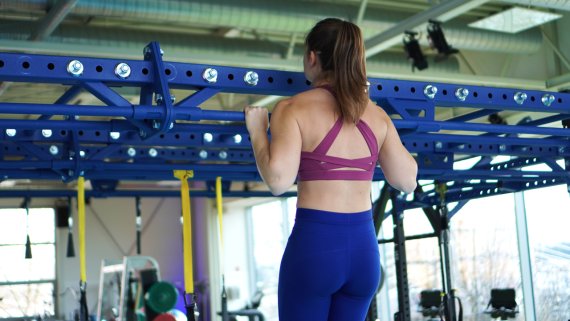
Pull-ups require strong muscles in the arms and shoulders, which are rarely used to the same extent in everyday life. Therefore, the exercise is not easy in terms of strength, but rather simple in terms of movement and is therefore one of the basics in calisthenics. It's not a big deal if you don't get it right the first time, because there are preliminary exercises to work your way up to the full pullup. To try a pull-up, hang with both arms on a pull-up bar or rings and pull yourself up until your chin is above the bar. Then lower your body in a controlled manner.
As preparation, it is helpful if you start by hanging on the bar for a while. For the right training effect you should already pay attention to an active body position. In this way, you already build up your grip strength as well as the holding muscles in your arms, shoulders and torso. If this goes well, you can next focus on your shoulder muscles by pulling your shoulder blades down and back together. Then, to work your way out to the full pull-up, you can use resistance bands to help. These provide great support to work out the full movement.
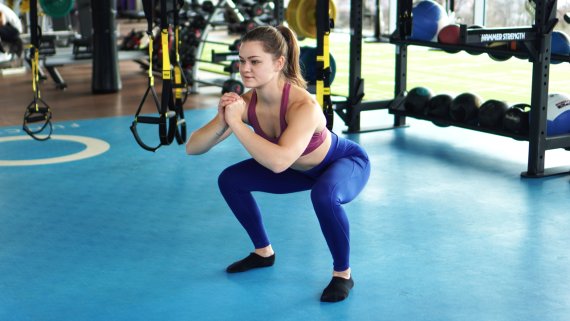
For the squats, stand upright with your feet slightly wider than hip-width apart. You can place your arms as you wish and, for example, stretch them out horizontally in front or support them on your hips. Then bend your knees as if you were going to sit down - if possible, you should go at least deep enough so that your thighs are parallel to the floor. Keep your upper body upright, hold the tension for a moment and then push yourself back up into an upright position. You can push your knees out over the tops of your feet, as long as you can put equal weight on the soles of your feet at the same time.
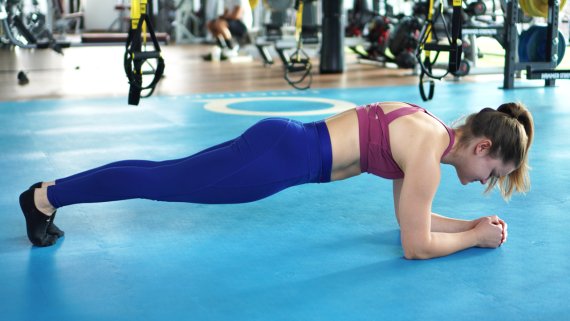
In the Plank, you get into a position similar to the starting position of the push-up. However, instead of having your arms extended, you are in a forearm support with your elbows bent. You can interlock your hands so that they form a fist. Or you can let your forearms point forward and place your hands flat on the floor. As with the push-up, the rest of the body forms a straight line. The abdomen is firm and you hold this position motionless for as long as you can. Start by working toward one minute and then slowly increase the time. More experienced people can easily hold this position for four or five minutes.
Once you've had some practice and have a better understanding of your body, it's time to move on to the typical calisthenics exercises on equipment. It is helpful to think about your strengths and weaknesses in advance. This way, when you create a training plan, you can adjust the weighting so that you gradually compensate for your weaknesses. For example, if you notice that your abdominals always sag a little in the plank, you can train your abdominal muscles more. If your upper body lacks strength, you can focus on push-ups and pull-ups. If you can't do an exercise like the pull-up yet, there are again easier variations to strengthen the same muscle groups. Advanced exercisers usually train three times a week without any problems. If necessary, a fourth, lighter workout can be added. However, be careful not to overdo it and learn to listen to your body. If your muscles are very sore, it is better to take a break and rest for a few days until you get back to training. Below you will find some of the best advanced calesthenics exercises:
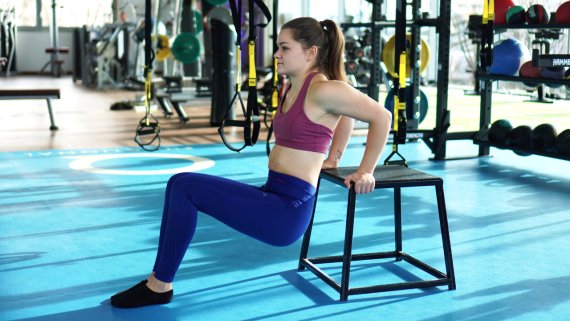
For the dips you need a bar with two bars at the same height. First, push yourself up in a neutral grip so that your arms are straight. While keeping your upper body upright, bend your arms close to your body while elbows point back. When your upper and lower arms reach an angle of about 90 degrees, pause here briefly - and then push yourself back up. This exercise also requires a high degree of strength and body control. If you are not yet able to perform the dips, you can practice on the floor instead. From a seated position, place your feet in front of you and push your pelvis up into a tabletop position. Now bend your arms back and lower your butt toward the floor before pushing yourself back up to a horizontal position.
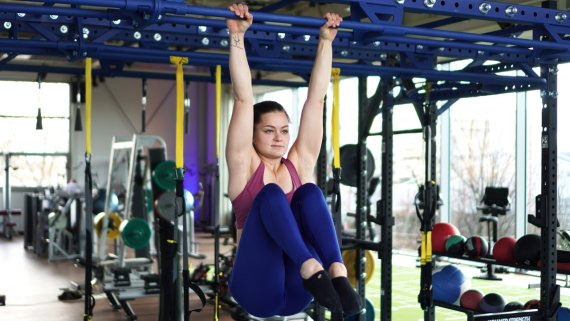
For this calisthenics exercise you need a wall bars or a pull-up bar. First hang straight on the bar. Then lift your legs as far as you can. Then lower your legs back down in a controlled manner. Always make sure that you don't make any jerky movements, but that you come out of an exercise just as mindfully and powerfully as you came in. There is also a good simplified alternative for this advanced exercise: lie on your back on the floor and stretch your legs towards the ceiling. Now slowly lower your legs stretched towards the floor and then bring them back up.
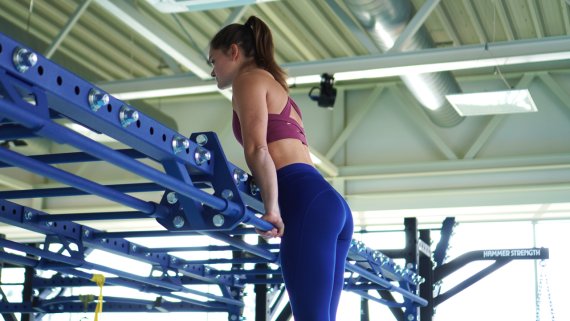
The Muscle Up is an extension of the pull-ups and can also be performed on a bar or with rings. So the movement also starts on a slope with arms outstretched. After the first part - the pull up - the upward movement is then continued at the highest point of the pull up. To do this, the hands must rotate a little around the bar or rings, so that the wrists can be set up and a transition into a supporting movement is possible. From there, the arms are extended to push the torso over the bar until you are in a supporting position. To return to the starting position, one performs the movement backwards. This backward movement is also suitable for understanding the technique as well as building strength in each section of the movement. In general, Muscles Ups require not only strength, but also good technique in order to avoid incorrect loads.
Unless you are pursuing an individual goal that requires its own training parameters, it is recommended, whether beginner or advanced, to perform two to three sets of all calisthenics exercises per training session. In the beginning, you should perform between 12 and 15 repetitions of each exercise in order to train your strength endurance. You should not reach muscle failure, especially if the exercises are new to you, so that you can always concentrate on the correct execution and technique. After each set, take a break for about two minutes to catch your breath and let your muscles recover a bit. If you find that you can't do 12 reps, you can try replacing the exercise with an easier variation. If you still have strength after your set, it's time to replace the exercise with a more strenuous alternative.
Incorporating the best calisthenics exercises into your routine will help you build strength and mobility efficently. Of course, it is important to maintain your enjoyment of the workout. Try to find out what motivates you and keeps you going. This could be a training group or buddy. You may also want to keep a small notebook where you can document your workouts and keep track of your progress. Soon you will realize that your body is capable of much more than you always thought.
Of course, it is important not to overstrain yourself, especially at the beginning. Otherwise, in addition to severe muscle soreness, more serious overuse symptoms can force you to take a longer break from training. Give your body the necessary break so that you can quickly get fit again after the muscle soreness. In addition to the exercise selection, you can also adjust the training frequency accordingly. For example, start by exercising only twice a week. When you feel that your body is getting used to the strain over a period of a few weeks, you can add a third training session. Each workout should also include a warm-up and cool-down. Preparation and follow-up are essential to achieve good performance in training and to reduce the risk of injury. So now let's move on to the specific exercises. The following three exercises are wonderful for beginners to build strength and get into training. In addition, all three do not require any equipment or tools.
In average, calisthenics burns about 300 - 500 calories per hour. However, it's about how intense your workout is - a beginners workout will burn less calories than exercising on high intensity.
What is Calisthenics?
Calisthenics is a street workout using bodyweight exercises like push-ups and squats, emphasizing controlled, graceful movements. It promotes muscle building with minimal equipment.
What are basic Calisthenics exercises?
Basic exercises include push-ups, squats, sit-ups, and more. These movements, performed without equipment, form the foundation of calisthenics.
What are the advantages of Calisthenics exercises?
Calisthenics improves posture, reduces tension, and builds muscle. It offers a full-body workout, enhances coordination, and fosters a sense of focus and balance through controlled movements.
What are good Calisthenics exercises for beginners?
Beginners should start with dips, push-ups, handstands, pull-ups, squats, planks, and more. Mastering basics before progressing prevents injuries.
How can Calisthenics exercises be made more challenging?
Increase difficulty gradually by altering exercises or intensifying repetitions. For example, elevate hands during push-ups or use resistance bands for pull-ups.
What are advanced Calisthenics exercises?
Advanced exercises include dips, leg raises, muscle-ups, demanding greater strength and technique. These are performed on equipment like bars or rings.
What's the recommended training structure for Calisthenics?
Perform two to three sets of each exercise, aiming for 12-15 repetitions initially. Avoid muscle failure, take two-minute breaks, and progress to more challenging variations.
How many calories does Calisthenics burn?
On average, calisthenics burns 300-500 calories per hour. The intensity determines calorie expenditure, with higher intensity workouts burning more calories.
How often should Calisthenics be practiced?
Beginners can start with two sessions per week, gradually increasing frequency. Listen to your body, incorporate warm-ups, and maintain a balance to avoid overtraining.
Can Calisthenics be practiced without equipment?
Yes, calisthenics can be performed without equipment, utilizing bodyweight for exercises. Beginners can use everyday structures like playgrounds or trees.
 Know-HowThe 11 Best TRX Exercises
Know-HowThe 11 Best TRX Exercises
- ISPO awards
- Mountain sports
- Bike
- Design
- Retail
- Fitness
- Health
- ISPO Job Market
- ISPO Munich
- ISPO Shanghai
- Running
- Brands
- Sustainability
- Olympia
- OutDoor
- Promotion
- Sports Business
- ISPO Textrends
- Triathlon
- Water sports
- Winter sports
- eSports
- SportsTech
- OutDoor by ISPO
- Heroes
- Transformation
- Sport Fashion
- Urban Culture
- Challenges of a CEO
- Trade fairs
- Sports
- Find the Balance
- Product reviews
- Newsletter Exclusive Area
- Magazine
